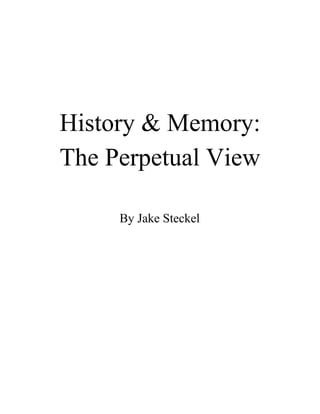
History & Memory Perspective
- 3. 2 personal relations with it, is profound in its own right. In his seminal work, On Collective Memory, he begins with the statement, “We preserve memories of each epoch in our lives… Through them, as by a perpetual relationship, our sense of identity is perpetuated.” 2 This notion is further explored by observing the consequence of personal memory in “reconstructing the past.” This implies that people’s relationships within groups arise from their memories as they exist in said social structures. The web of connections provides both a point of origin and a pressure to create more imprints on the society in which the individual occupies a place. This requires people to reform memories, conceived within and connected to the milieu, in order to contextualize their social environment and play an active role in everyday life. This is how memory becomes collective. However, a question arises from this when Halbwachs asks, “Is it not strange then that society causes the mind to transfigure the past to the point of yearning for it?” 3 Because some individuals instinctively retreats into memories of the past in order to escape the society of physical life, this presents a challenge in what memories come to represent. It is especially important not to make the mistake of viewing the “collective” as a simple collection of singular memories; Halbwachs does not mean to examine memory as just individual strands in a larger body, but the larger body of memory and how people exist within it. Furthermore, 4 Halbwachs makes the claim that, while collectives are inseparable, each has its own specific memories and therefore a totality of collectives is not seen on some grand scale. Thus one 2 Maurice Halbwachs (1992). On Collective Memory. Chicago, IL: University of Chicago Press, 47. 3 Halbwachs, 51. 4 Kansteiner, 186.
- 6. 5 broader worldview; without oversimplifying, it can be broken down into several stages. Within the context of memory, Pierre Nora provides a competent framework in which this can be done. While he does not look at the psyche like Halbwachs, or employ the same intensity of analysis that Assmann incorporates, Nora divides the progression of memory throughout history in three phases: the premodern, the modern, and the postmodern. 8 While the premodern phase encompasses the early habits of societies, from the dawn of cultural memory to its collapse in the eighteenth and nineteenth centuries, the modern and postmodern contain the breakdown of this dynamic, dealing more directly with why memory issues are so prevalent in today’s global society. Nora establishes that “peasant culture” is the basic root, again referring to the establishment of memory described earlier, of collective and cultural memory. Because culture was established at the ground level, this peasant base 9 naturally held the majority of historical societies, and therefore assumed more fully the identities of the objects into which they invested the legacy of their totality. Especially because such a culture was immobile, and was rarely displaced barring some catastrophic event, the villages and local communities not only interacted with their memories and culture. They were actually environments of memory in and of themselves. It is only when the Industrial Revolution began to escalate, Nora postulates, that these ways of preserving and utilizing cultural memory began to fall apart. The mass migrations from rural localities to cities, and the development of newer urban culture that lacked heritage or tradition, threatened the ability of the old order to survive. 10 It is this change which marks the transition from premodern to modern. The modern era of 8 Kansteiner, 183. 9 Pierre Nora (1989). “Between Memory and History: Les Lieux de Mémoire” Representations, 26, 7. 10 Nora, 14.